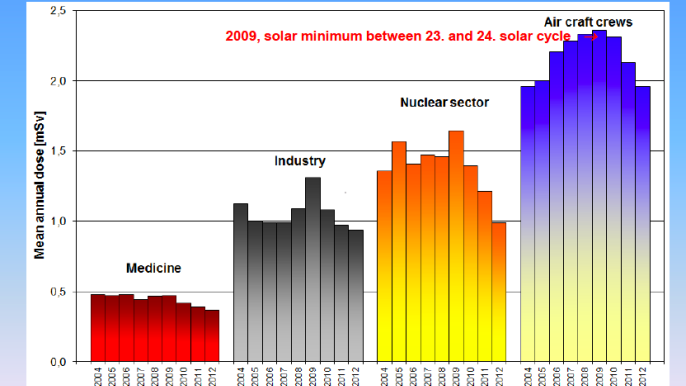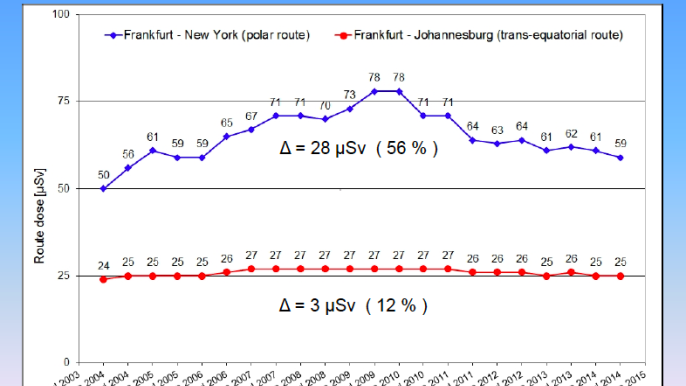
It is no exaggeration that flight operations in polar regions are faced with tremendous challenges. Unique planning and operational considerations are required due to the remote terrain, extreme temperatures, areas of magnetic unreliability, space weather, availability of ETOPS alternates and communications difficulties.
Some of these risk factors are plainly obvious, such as the extreme temperatures, while others are not. This article will focus on one of the risks inherent with flights at high altitudes and latitudes. The threat itself comes from space, but it certainly isn’t in the form of added warmth. It actually involves high-energy particles.
Dangerous Form of Radiation
Aviation students that I took to Switzerland in May 2019 for a Global Engagement academic course were given a wonderful introduction to this topic when we visited the world-famous Conseil Européen pour la Recherche Nucléaire (CERN) nuclear research facility in Geneva. The timing of our visit was fortunate. It was pre-COVID, and the famed Large Hadron Collider was undergoing periodic maintenance so the students were given an eye-level tour of the 27-km-long facility that is buried 100 meters below ground.
Our post-doctoral lecturers, who work side-by-side with distinguished Nobel Prize recipients, were excited to learn that these students were going into aviation and therefore customized our afternoon tour to highlight the current information about high-energy particles from space commonly referred to as “cosmic radiation.”
The lecturers explained that cosmic radiation is a collective term for the high-energy, charged particles from space that constantly bombard the Earth from all directions. Some of the particles come from our sun, but most are from deep space. Upon striking the outer atmosphere of the earth, these high-energy particles produce secondary showers of lower energy, mostly unstable, charged particles.
Our lecturers explained that cosmic radiation is quite different from other forms of ionizing radiation. In the high-altitude cruise environment, especially over the polar regions, roughly 50% of the radiation dosage from cosmic radiation is transmitted by neutrons. This differs from the radiation exposure to medical technicians giving X-rays.
In fact, research on the exposure of various professions to radiation has found that air crewmembers exhibit the highest annual exposure to radiation when compared with workers in the medical, industrial and nuclear industries. The U.S. National Council on Radiation Protection and Measurements reported that air crews have the largest average annual effective dose (3.07 mSv) of all U.S. radiation-exposed workers. In 1999, a U.K. National Radiological Protection Board study found that nuclear workers received a lower annual average dose of radiation (3.6 mSv a year) than air crews (4.6 mSv a year).

Source: Gerhard Frasch, German Federal Office for Radiation Protection, “Aircrew Exposure to Cosmic Rays: Challenges and Management,” International Conference on Occupational Radiation Protection, Dec. 15, 2014, in Vienna
Air-Crew Risk Factors
Several risk factors govern the exposure to flight and cabin crewmembers. In order of their relative importance, these include altitude, latitude and solar activity.
At sea level, the Earth's atmospheric layer provides a shielding effect equivalent to 13 ft. of concrete. While the exposure at sea level is about 0.06 μSv/h, at 35,000 ft. above sea level (the cruising altitude of commercial transport aircraft) the dose received is about 100 times more--6 μSv/h. (What is a μSv/h? It is the abbreviation for a microsievert. This is the scientific measurement of the energy received from a radioactive source or from other sources like X-rays in medicine.)
Even less protection is provided as the atmosphere becomes increasingly thin above the tropopause. Crewmembers could potentially be exposed to 13 μSv/h when cruising at 49,000 ft., roughly twice the amount of airline transport crews.

Source: Gerhard Frasch, German Federal Office for Radiation Protection, “Aircrew Exposure to Cosmic Rays: Challenges and Management,” International Conference on Occupational Radiation Protection, Dec. 15, 2014, in Vienna
Why would latitude make a difference? The Earth is shielded by two gigantic doughnut-shaped belts populated by energetic electrons and protons called the magnetosphere. This geomagnetic shielding deflects cosmic rays and protects us from solar flares.
Due to the shape of the magnetosphere, the difference in geomagnetic shielding between high and low latitudes has a marked effect on exposure rates. Charged particles striking the Earth near the equator tend to be deflected along the magnetic field lines toward the poles. Thus, more protection is provided closer to the equator and less near the poles.
Incidentally, during the CERN tour we were shown many other examples of how “space weather” directly affects aviation as well as critical infrastructure on the ground. Since geomagnetic shielding from the magnetosphere is markedly less over polar regions, this is another category of threats that must be evaluated prior to a polar flight.
The difference in protection during polar versus equatorial flights is significant. Flights cruising at 36,000 ft. over the Hudson Bay would receive 6-7 μSv/h of radiation versus 2-3 μSv/h over Southern California or Florida, according to data presented by Gerhard Frasch (German Federal Office for Radiation Protection to the International Conference on Occupational Radiation Protection on Dec. 15, 2014, in Vienna).
Dr. Christopher Mertens, a senior scientist at NASA’s Langley Research Center in Hampton, Virginia, examined data from polar flights during a solar storm in 2003. The data revealed that passengers received about 12% of the annual radiation limit recommended by the International Committee on Radiological Protection during a single flight. The exposures were greater than on typical flights at lower latitudes and confirmed concerns about commercial flights using polar routes.
Bursts of cosmic radiation are unleashed toward the Earth during solar flares. Normal solar activity fluctuates throughout its 11-year cycle. The maximum flux of solar radiation increases the exposure by about 25% and the corresponding solar minimum increases it by about 25%. Prediction of this influx of additional cosmic radiation is critical during solar events, especially since the recommended annual limit can be exceeded in just one high-latitude flight.
Is it possible for flight departments to determine the activity level of space weather? Yes. The Space Weather Prediction Center of the National Oceanic and Atmospheric Administration provides alerts, watches and warnings. It includes the effects of space weather on GPS systems, HF radio communications and satellite communications. Its website is located at https://www.swpc.noaa.gov/products/alerts-watches-and-warnings
Being Informed
The beginning of the CERN tour started in the same lecture hall where the faculty of this world-famous scientific institute erupted into mass applause when their colleagues were announced as recipients of the Nobel Prize in physics in 2013. While sitting in this respected setting, a student from our group pointed to their smartphone and said, “Look what I found on the internet. This article says that cosmic radiation isn’t a threat to aviation.”
One of the tour leaders replied to the student, “Watching one or two videos on YouTube or looking at the first couple of articles you find on Google doesn’t make someone an expert.” This tour leader then leaned toward the other two tour leaders and quietly remarked, “I can’t believe pilots would look at an internet article for important information.” Mercifully, several of the tour leaders were patient enough to explain important aspects of being an informed consumer of information when the internet is nothing less than “The Wild, Wild West.”
In today’s society, it is far too common for a sensationalized statistic to be splashed across the headlines of a news story, and the unsophisticated information consumer won’t be aware of the practical limitations of the simplistic statistic. Most students do not enjoy the brief introduction to statistics in their high school or college curriculum, further rendering many information consumers susceptible to manipulation or unable to discern the proper applications and limitations of data collection and analysis.
One of the most re-quoted statistics on this topic comes from the National Institute for Occupational Safety and Health. NIOSH has estimated that pilots fly through about six solar-particle events in an average 28-year career. At face value, this seems like a trite exposure risk. It would be tempting to shrug your shoulders and form an opinion that any further mention of cosmic hazards to air crewmembers is exaggerating the risk.
CERN’s tour leaders led the students into a short discussion about the limitations of drawing sweeping inferences from studies using demographic samples. According to data collected by the U.S. Bureau of Transportation Statistics, there were 10.2 million scheduled airline flights in the U.S. in 2019. The proportion of flights that do not venture into portions of the atmosphere with elevated levels of exposure far outbalances the small number that do. Thus, when a data sample is collected from the pilot population, the vast majority of pilots haven’t been flying in regions of higher risk. This “bias” in the data will certainly sway a study’s statistical conclusions.
The bottom line for an individual pilot who flies within domestic U.S. airspace and doesn’t fly in the upper flight levels is that his/her exposure to cosmic radiation is indeed small. On the other hand, if you enjoy flying international flights whose Great Circle routes take your aircraft’s trajectory close to the polar regions as you cruise in the upper portions of the flight levels, your individual exposure will be far greater than “the average.”
The second part of this article series will examine how pilots can protect themselves when flying polar routes.





